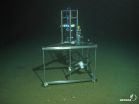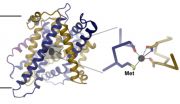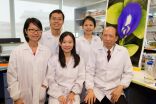Cold sores increase the risk of dementia
2014-10-20
(Press-News.org) Infection with herpes simplex virus increases the risk of Alzheimer's disease. Researchers at Umeå University, Sweden, claim this in two studies in the journal Alzheimer's & Dementia.
"Our results clearly show that there is a link between infections of herpes simplex virus and the risk of developing Alzheimer's disease. This also means that we have new opportunities to develop treatment forms to stop the disease," says Hugo Lövheim, associate professor at the Department of Community Medicine and Rehabilitation, Geriatric Medicine, Umeå University, who is one of the researchers behind the study.
Alzheimer's disease is the most common among the dementia diseases. In recent years research has increasingly indicated that there is a possible connection between infection with a common herpes virus, herpes simplex virus type 1, and Alzheimer's disease. A majority of the population carries this virus. After the first infection the body carries the virus throughout your lifetime, and it can reactivate now and then and cause typical mouth ulcer. The hypothesis which links the herpes virus and Alzheimer's disease is based on that a weakened immune system among the elderly creates opportunities for the virus to spread further to the brain. There this can in turn start the process which results in Alzheimer's disease.
Hugo Lövheim and Fredrik Elgh, professor at the Department of Virology, have now confirmed this link in two large epidemiological studies. In one study, which is based on the Betula project, a study on ageing, memory and dementia, the researchers show that a reactivated herpes infection doubled the risk of developing Alzheimer's disease. This study had 3,432 participants who were followed for 11.3 years on average. In another study, samples donated to the Medical Biobank at Umeå University from 360 people with Alzheimer's disease were examined and as many matched people who had not developed dementia. The samples were taken on average 9.6 years before diagnosis. This study showed an approximately doubled risk of developing Alzheimer's disease if the person was a carrier of the herpes virus.
"Something which makes this hypothesis very interesting is that now herpes infection can in principle be treated with antiviral agents. Therefore within a few years we hope to be able to start studies in which we will also try treating patients to prevent the development of Alzheimer's disease," says Hugo Lövheim.
INFORMATION:
Read the studies in Alzheimer's & Dementia
Reactivated herpes simplex infection increases the risk of Alzheimer's disease
http://www.ncbi.nlm.nih.gov/pubmed/25043910
Herpes simplex infection and the risk of Alzheimer's disease – A nested case-control study
http://www.alzheimersanddementia.com/article/S1552-5260(14)02770-8/abstract
[Attachments] See images for this press release:

ELSE PRESS RELEASES FROM THIS DATE:
2014-10-20
A study by researchers of Ludwig-Maximilians-Universitaet (LMU) in Munich shows that infants fed on fresh rather than UHT cow's milk are less prone to infection. The authors recommend the use of alternative processing methods to preserve the protectants found in the natural product.
A pan-European study, led by Professor Erika von Mutius, Professor of Pediatric Allergology at LMU and Head of the Asthma and Allergy Department at Dr. von Hauner's Children's Hospital, reports that fresh cow's milk protects young children from respiratory infections, febrile illness and inflammation ...
2014-10-20
A desert at the bottom of the sea? Although the waters of the North Sea exchange about every two to three years, there is evidence of decreasing oxygen content. If lower amounts of this gas are dissolved in seawater, organisms on and in the seabed produce less energy – with implications for larger creatures and the biogeochemical cycling in the marine ecosystem. Since nutrients, carbon and oxygen circulate very well and are processed quickly in the permeable, sandy sediments that make up two-thirds of the North Sea, measurements of metabolic rates are especially difficult ...
2014-10-20
To make a decision for or against adjuvant chemotherapy, a test to measure the concentrations of the biomarkers uPA and PAI-1 in the tumour tissue is available for breast cancer patients. However, as suitable studies are lacking, it remains unclear for patients with an intermediate risk of recurrence which benefit or harm a treatment strategy based on this test may have for them. This is the result of the final report published by the Institute for Quality and Efficiency in Health Care (IQWiG) on 20 October 2014.
Adjuvant systemic treatments aim to prolong survival
Even ...
2014-10-20
Individuals who are genetically predisposed to obesity may soon have a therapeutic solution to combat their condition. A research team led by scientists from the National University of Singapore (NUS) has identified several potent inhibitors that selectively target FTO, the common fat mass and obesity-associated gene. These FTO-specific inhibitors pave the way for the development of novel anti-obesity drugs and treatments.
The research, led by Assistant Professor Esther Woon from the Department of Pharmacy at the NUS Faculty of Science, along with colleagues from the ...
2014-10-20
In a world of matinee idols and cover girls it's easy to assume that humans want their men to be manly and their women womanly.
But a groundbreaking new study suggests that, rather than being a preference passed down through a long process of social and sexual selection, it's a relatively new habit that has only emerged in modern, urbanised societies.
A team of psychologists, anthropologists and biologists, led by Brunel University London, surveyed 12 populations around the world, from the primitive to the highly developed.
Surprisingly, only in the most industrialised ...
2014-10-20
Iron is the most abundant trace element in humans. As a cofactor of certain proteins, it plays an essential role in oxygen transport and metabolism. Due to the major importance of iron in a wide variety of cellular processes, and the harm caused by its uncontrolled accumulation in the body, its uptake and storage is strictly regulated. In mammals, iron is imported into cells by the membrane transport protein DMT1. Mutations of DMT1, which affect its transport properties, lead to iron-related metabolic disorders such as anemia and the iron storage disease hemochromatosis.
Ines ...
2014-10-20
How did life originate? And can scientists create life? These questions not only occupy the minds of scientists interested in the origin of life, but also researchers working with technology of the future. If we can create artificial living systems, we may not only understand the origin of life - we can also revolutionize the future of technology.
Protocells are the simplest, most primitive living systems, you can think of. The oldest ancestor of life on Earth was a protocell, and when we see, what it eventually managed to evolve into, we understand why science is so fascinated ...
2014-10-20
The drug combination umeclidinium/vilanterol (trade name Anoro) has been approved since May 2014 for adults with chronic obstructive pulmonary disease (COPD). In an early benefit assessment pursuant to the Act on the Reform of the Market for Medicinal Products (AMNOG), the German Institute for Quality and Efficiency in Health Care (IQWiG) examined whether this drug combination offers an added benefit over the appropriate comparator therapy.
According to the findings, an added benefit is not proven: For patients with moderate COPD severity and patients with fewer than ...
2014-10-20
Scientists at Nanyang Technological University (NTU Singapore) have discovered a new molecule which can join together chains of amino acids – the building blocks of protein.
Only three other known molecules have been discovered to be able to perform this function, which is an important process in the development of new drugs. A key difference is that the new molecule is able to do the same process 10,000 times faster than the other three and "cleanly" without leaving any residue behind.
This new molecule, which is a type of catalyst or enzyme, was derived from ...
2014-10-20
Researchers at VTT Technical Research Centre of Finland, the University of Turku and the University of Oslo have discovered a previously unknown molecular-level mechanism that may partly explain the increased growth of cancer cells. The study, published in the British Journal of Cancer, showed that high levels of miRNA-378a-5p molecule cause cell division anomalies. This renders the number of chromosomes in cancer cells abnormal, which is known to promote growth and the spread of cancer. In addition, the researchers discovered that elevated miRNA378a-5p levels in breast ...
LAST 30 PRESS RELEASES:
[Press-News.org] Cold sores increase the risk of dementia



